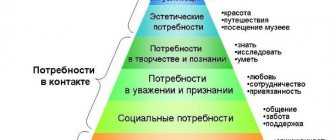What is motivation and why is it needed?
In simple terms, a motive is the reason why we want to achieve a certain goal.
It is clear that positive motives are much more effective. When we really want something strongly, it is much easier to move towards the goal. Expecting rewards or receiving genuine pleasure from an action will contribute to positive motivation.
Any human development (professional and/or personal) is not complete without motivation. In psychology, motivation is also defined as the process of managing a set of motives that prompt a person to act. That is, a competent specialist is able to adjust the client’s motives so that the goal is achieved with the best result.
Basic human motives, examples
The main factors stimulating and determining the behavior of an individual include those aimed at biological survival. They are laid down by nature and cannot be changed by willpower.
Some of these motives are cyclical in nature - food intake, sleep and wakefulness phases. Obvious examples are obtaining food and extracting additional resources. The main motives stimulate the work activity of an individual and economic processes in social formations.
The accumulation of material assets, the production of basic household items and food products are aimed at satisfying natural human needs. This includes the production of heating products. The motivation for such activity is to increase life expectancy.
In psychology, a motive is an individual’s desire to satisfy his own basic needs. Such considerations force states to develop science, technology, and medicine. At the heart of complex economic and social processes lies a simple desire to satisfy the basic needs of all members of the social formation.
Many basic motives are not given importance in everyday life, but they act as the driving force of any activity. Such stimulating factors include the subconscious desire to avoid danger, dictated by the instinct of self-preservation.
The search for shelter, the desire to protect oneself, to create the most favorable conditions for life are considered the main and fundamental motives. The main behavioral stimuli are individual psychological characteristics that have a strong influence on a person’s actions in different situations.
They are socially conditioned or have a personal innate nature. Motivation can be functional and serve the purposes of cultural development of the individual. Such incentives force people to buy expensive tickets to a concert, theater, or contemporary art exhibition.
Signs of a motivated personality
People who are charged with action can be easily recognized. They:
- optimistic (a motivated person is confident in advance of a good result);
- active (show enthusiasm, which helps not to stop in the process of achieving the goal);
- persistent (follow the rule that any obstacles that arise can be overcome);
- concentrated (try not to be distracted by small things);
- self-confident (they feel like a whole person with their shortcomings, but at the same time they not only know how to use their strengths of character, but also work on their weaknesses).
The problem of the struggle of motives
At the same time and in parallel, the individual is under the influence of numerous multidirectional stimulating factors. This is the most important concept of volitional activity. The struggle of motives is aimed at determining the dominant and dominant stimulus.
Its logical outcome is the formation of a mature personality, understanding of life priorities, and the ability to make decisions independently. Some motives have ambivalent meaning. Example: is it worth accepting the help of an unpleasant or a priori unfriendly person?
Such dilemmas that haunt an individual throughout his life constitute the essence of the struggle of motives. A typical example is a choice between positive but incompatible goals. Making a decision often requires willpower. It is not recommended to make difficult life choices under the influence of emotions.
Motive in psychology is also a constant struggle of multidirectional stimuli and motivations. A clear definition of value guidelines helps you make error-free choices. Psychologists recommend drawing up a personal motivational scheme to ease internal struggles.
Types of motives in psychology
Psychologists count many circumstances that guide a person in achieving goals, so it is not easy to clearly define the classification of motives, especially since several reasons often prompt action at the same time. It is generally accepted that the main two types of motivation are internal and external.
1. INTERNAL MOTIVES
arise from one’s own thoughts, hobbies, needs for positive emotions and the desire to enjoy one’s actions. Examples of internal motivation would be the desire to:
- to achievements (improvement of professional qualities, quality of life, promotion, acquisition of the desired social status);
- to personal growth (characterized by the desire to learn new things, improve, change behavior);
- to social needs (the desire to find like-minded people, to gain support and affection in communication/friendship/love);
- to power and recognition (to establish control over one’s life and/or the lives of others).
2. EXTERNAL MOTIVES
do not depend on a person’s personal desires, but are dictated by circumstances (public opinion, laws, world events, rules, weather conditions, the desire to receive encouragement or avoid punishment). Examples of extrinsic motivation would be:
- material reward (money is one of the simplest and most understandable ways to get a return on your actions);
- recognition of merit (when we are praised for our work and set as an example for others, we also receive strong moral satisfaction);
- fear (the desire to avoid an uncomfortable, difficult situation, fear of a reprimand or fine are also incentives to action).
External and internal motivations can influence the actions of an individual, both separately and in combination. For example, a student tries to do his homework well. He can do this for several reasons at once: out of sincere interest in the subject, so as not to upset his parents, in order to get a good grade and show off to his friends.
Functions of motives
To explain the background of any behavior, reactions to changes in conditions or actions in psychology, extrinsic (external) or intrinsic (internal) reasons are used. They are closely related to the basic functions of motives. There are 3 of them - motivation, direction, regulation.
Psycho-emotional qualities are considered external factors that determine an individual’s behavior:
- satisfaction of natural needs;
- achieving your goals;
- realizing your own desires;
- following your interests or hobbies.
The incentives that guide behavior are based on the functions of motives. Motivation provokes the commission of certain actions, gives psycho-emotional impulses or emotional impulses relevance.
The guiding function helps to choose the right path to solve a problem. Regulatory forces one to adhere to the mores, norms and rules prevailing in a social environment or social group. It gives legitimacy to internal motives.
Functions are similarly influenced by external stimuli. When guided by extrinsic motives, they activate other characteristics of the individual. Therefore, motivational functions in psychology are considered in a dual context.
Some are classified as biological, considered innate, and provide survival. Such functions of stimulating factors are aimed at satisfying basic physiological needs - satisfying hunger, thirst, sleep.
They are inherent in any biological organism, since they are dictated by nature. Maternal instinct is considered one of the most powerful motivating factors. The biological functions of motives include thermoregulatory, excretory, and the desire to avoid pain or discomfort.
People are characterized by secondary stimulating factors acquired during life, dictated by the prevailing external conditions and social environment. Interpretations of the functions of the motifs are given in the table.
| Function | Characteristic |
| Balance | It is activated when an individual experiences a deficiency in something and acts until the lost balance is restored. |
| Needs | Serves as a response to the desire to satisfy physiological, psycho-emotional, aesthetic or other needs. |
| Cognitive | Encourages actions aimed at achieving a set goal or solving a current problem. |
| Behavioral | Dictated by social rules and norms, may change depending on external conditions. |
The motif has selective functions and individual properties that change over time. In psychology this is called adaptive ability. Inducing factors and their functions are not the same in terms of their impact on the individual.
Stages of motivation
Motivation is an extensive process that takes place in several stages.
- At the beginning of the journey, a person has a need that he wants to satisfy.
- At the next stage, ways to do this are identified.
- Next, a specific goal is set - what exactly needs to be achieved in the final.
- The last stage is the longest - these will actually be specific actions, work in the chosen direction.
If the result is successful, the person achieves the desired reward and remains satisfied. If there is a failure, this may negatively affect future plans. It is clear that next time it will be much more difficult to motivate a person who has already failed.
Practical psychologists help organize a comfortable environment for productivity growth and choose a specific method of motivation, because you need to take into account the individual characteristics of the individual, the accompanying factors of her life and other important points.
Our distance learning course in practical psychology will help you learn how to provide psychological services. You will not only master all the techniques for diagnosing and correcting psychological conditions, but also gain the right to apply them in practice to help people solve their problems and achieve their goals.
What is the subordination of motives?
This is a key concept in the formation and development of personality. The first signs of subordination of motives appear at an early age. Various stimulating factors lose equal importance and form a system of personal values and life guidelines.
This structure is called an individual motivational scheme. Dominant and secondary motivations constitute a hierarchy in which there is a difference in levels and strength of influence.
Subordinate motives of adolescence include:
- self-affirmation;
- desire to achieve sports success;
- the emergence of moral qualities;
- behavioral assessment.
To prevent ethical deformation of the individual, subordinate motives are built into a hierarchical system by educational means. The most difficult moment during the period of an individual’s psychological formation is the choice between personal and social values.
The subordination of motives is formed in the struggle of these factors to create a reasonable compromise. It starts in preschool age. The result of this step-by-step process is considered to be motivational readiness, which is closely related to the concepts of cognitive interest and initiative.
Motivation methods
To maximize the chances of success, it is important to start immediately with the right motivation and maintain methodological moves over time. We have collected tips for you on how to do this.
- Start small
. The lighter and simpler the initial goal, the better. For example, if you want to play sports, do not immediately plan two-hour intense exercise, but train for the first week for 3-5 minutes a day. - One goal is enough at the start of your journey.
Many parallel goals will disperse your attention and energy, and there is a high probability that you will achieve nothing in the end. It is better to concentrate all resources on one point. - State your goal publicly.
We all avoid the awkwardness that arises if we fail to keep our word. Telling friends or colleagues about your plans means taking responsibility for the result. - Look forward to victory.
A positive attitude and self-confidence are very important supporting factors at this stage.
Category personality in the history of psychology
Category personality
appeared in psychology relatively recently, although questions about the essence of man, the development of his self-image and self-assessment were posed back in antiquity. However, at that time the concept of personality
and
man
were considered identical, and the modern concepts of
personality, individual
and
individuality did not exist.
For a long time, as already noted, the leading subject of psychology was cognition, and the categories of image and internal, mental activity remained leading. It is not without reason that the famous scientist W. Wundt spoke about the dictates of “intellectualism” in psychology, contrasting his voluntaristic psychology with the old one, which studied mainly the “knowing person” and not the feeling one. Only with the advent of the school of depth psychology did personality become one of the leading categories and remains so in modern psychological science, although at present different schools (humanistic, depth, domestic psychology) consider the structure, genesis and driving forces of personality development according to -different.
The theory of principles of goal setting by E. Locke
The main idea of the theory was that the quality and characteristics of a person’s life directly depend on the goals that he sets for himself, therefore goals should be drawn up taking into account the factors missing for happiness according to the following principles:
- A specific task (the person must clearly understand what exactly needs to be done and how);
- The goal should not be easily achievable or require no effort and time.
- It is easier for a person to strive for results if the goal is set by him and is his own desire.
- Feedback is necessary (without an outside perspective it is more difficult to assess your potential and results).
- Willingness to use all resources to achieve results.
Definition
What is motivation? To have at least the slightest idea about such a concept as motivation, let’s look at its definition. In Latin, "muvere" (to move) defines the word "motive", which is a derivative of the word "motivation".
Thus, we can give several options for the concept of this word:
- encouragement to action;
- a psychophysiological process that controls human behavior, setting its direction, organization, activity and stability.
- a set of motivating factors that determine human activity.
An example would be a desire caused by hunger. A person strives to get food in order to satisfy his desire. Positive emotions are caused by the fact that the goal is close, and negative emotions - if such an opportunity is not foreseen in the near future, in this case dissatisfaction appears.
McClelland's theory of needs
The meaning of the theory is that a person should not deal with already satisfied needs, but focus on needs of a higher level:
- on the desire for success, professional and personal growth;
- on the desire to be part of society and occupy a prestigious position in it;
- on the acquisition of power, which involves the formation of a high share of responsibility and makes it possible to control the lives of other people.
We hope that our article will be useful to you and will help you take steps towards mobilizing all internal resources to improve your life.
Application in various fields
Psychologists have identified different methods of motivation that can be effectively used in work, relationships, etc. The most effective include methods used in psychology, management, and economics.
In psychology
Techniques:
- Self-hypnosis is a process by which a person independently influences his psyche. The main goal is to change behavior, actions, beliefs, interests. With the help of self-hypnosis, a person can make his behavior unusual. For the method to work, you need to prepare a list of attitudes and statements that seem correct. When making statements, you cannot use the particle “not”.
- Affirmations are expressions or small texts that can be used to influence a person on a psychological level. For affirmations to work, you need to divide a blank sheet of paper into two parts. On the left write negative statements that cause fear and anxiety, on the right - positive ones. It is important to write down negative statements in detail to reveal hidden fears. After this, you need to cut the sheet into two parts, carry the side with positive affirmations with you constantly, reading them every day.
- Self-motivation is the desire, the desire to continue activities when natural motivation is lost. You need to constantly look for reasons that will make you continue to act so as not to give up.
In management
Motivation techniques used in management:
- Economic - material incentives. These include increased wages, financial assistance, bonuses, and loans.
- Non-economic - moral, psychological or organizational. These include praise, support, approval, trust, respect, blame, prospects for further growth, delegation of authority, tasks.
Motive: stable and unstable
A sustainable motive is, of course, based on the needs of the individual. Such needs have existed for quite a long time, but unstable ones change quickly. Internal needs of the individual are stable and change slowly. This may include:
- vision of the world;
- interests;
- hobbies;
- tastes and preferences.
External motive is subject to constant changes, since public opinion (to which people often unwittingly listen), weather, views and interests of society are in an unstable state.
Thank you for reading the article to the end and do not forget to share the information on social networks, because it is not difficult for you, but it is pleasant for us.









